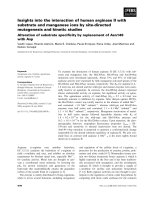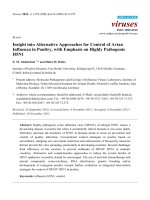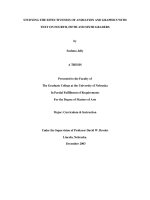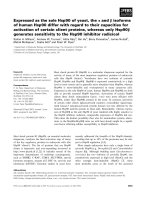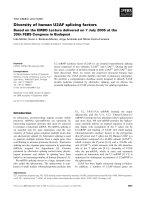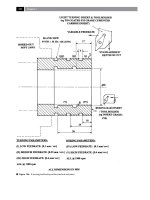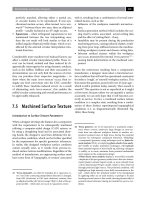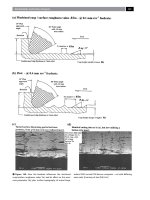Hanbook of human reliability analysis with emphasis on nuclear power plaint applications
Bạn đang xem bản rút gọn của tài liệu. Xem và tải ngay bản đầy đủ của tài liệu tại đây (33.03 MB, 728 trang )
NUREG/CR- 1278
SAND80-0200
RX, AN
Printed August 1983
Handbook of Human Reliability Analysis
with Emphasis on
Nuclear Power Plant Applications
Final Report
A. D. Swain, H. E. Guttmann
Prepared by
Sandia National Laboratories
Albuquerque, New Mexico 87185 and Livermore, California 94550
for the United States Department of Energy
under Contract DE-AC04-76DP00789
...
"
Wi
P
It
II
.
1 Prepa-red for
U.,SQ.NUCLEAR REGULATORY
,I
IT,,I
; h " COMMISSION"
, , , . . . . , . . ; ,'
SF2900Q(8-81 )
•
.
0
NOTICE
This report was prepared as an account of work sponsored by an
agency of the United States Government. Neither the United
States Government nor any agency thereof, or any of their employees, makes any warranty, exprcssed or implied, or assumes any
legal liability or responsibility for any third party's use, or the
results of such use, of any information, apparatus product or
process disclosed in this report, or represents that its use by such
third party would not infringe privately owned rights.
Available from
GPO Sales Program
Division of Technical Information and Document Control
U.S. Nuclear Regulatory Commission
Washington, D.C. 20555
and
National Technical Information Service
Springfield, Virginia 22161
0
A.
September 1, 1985
Addendum #1 to NUREG/CR-1278,
D.
Swain
August 1983
Following are some corrections to the above document, listing the
Understandable typos are
page (p) and paragraph (para) numbers.
excluded.
Some updating of references is included.
p.para #
3-14,5
Description of Corrections
Line 3:
...
are doubled for step-by-step tasks and
quintupled for dynamic tasks.
Line 6:
...
However,
of human reliability,
this
e.g.,
an additional
factor of 2 increase in the estimated HEP.
This is an
[For further explanation, see the change for p 17-7.]
3-35,5
Line 4:
... is generally correct, and is known as the
Inverted-U Hypothesis or the Yerkes-Dobson Law
(Welford, 1974; Fitts and Posner, 1967).
This means
6-3,5
Line 7:
Beare,
Dorris et al,
6-5,6
Line 6:
(1984)
under ...
7-15
Table 7-3, item (1)(a):
.01 (EF=3, 5, or 10)
[This addition agrees with Table 7-2 which indicates
conditions when any one of these EFs is relevant.]
1982,
1983).
No ...
11-8
Table 11-2 title,
line 2:
...
displays
displays no longer annunciating) for ...
11-16
Table 11-4, item (7): The ** should be followed by the
same "cross" footnote symbol used for item (8).
11-51
Table 11-13, add to last footnote:
The Pr[Fi] column
assumes that all of the ANNs (or completely dependent
sets of ANNs) are equal in terms of the probability of
being noticed.
See page 11-52, paragraph 2, if this
assumption does not hold.
12-8,4
Line 7:
12-12,3
Line 4 & 5:
12-13
Table 12-3:
The 3 lines in the figure should meet at
the 1.0 Pr[F] rather than at the .9 HEP.
Also, the 1
(e.g., HEP of 1.0) is incorrectly placed; it should be
in the same relative position above the .9 HEP as is the
.1 HEP above the .09 HEP.
The Pr[F] values for the
lower bound and median HEPs at 10 minutes are correct.
The Pr[F] values for the upper bound HEP at 20 minutes
should be 1.0.
...
(or annunciated
emergency operating procedures
...
Wreathall
(1981,
p 104,
...
and 1982),
-2-
12-20
The 3 lines in the figure should meet at
Table 12-4:
Also, the 1
the 1.0 Pr[F] rather than at the .9 HEP.
(e.g., HEP of 1.0) is incorrectly placed; it should be
in the same relative position above the .9 HEP as is the
The Pr[F] values for the
.1 HEP above the .09 HEP.
lower bound and median HEPs at 10 minutes are correct.
The Pr[F] values for the upper bound HEP at 10 minutes
should be 1.0.
13-6
(3), and (4) correctly pertain
Items (2),
Table 13-3:
to the potential error, "Select wrong control on a panel
There
from an array of similar-appearing controls."
should have been another item comparable to item (1) in
In order not to change the item
Table 11-2 (p 11-8).
numbers in Table 13-3, insert the following item after
item (1):
(1A)
17-7
Negligible
Select wrong control when it is
dissimilar to adjacent controls
...
Footnote, line 3:
factor of 2 because ...
multiplied by an additional
[The intent of this change is to enable an analyst to
apply the factor of 2 for step-by-step tasks or 5 for
dynamic tasks, as discussed in paragraph 6 for "heavy
task loading," and then to further increase the
resultant HEP by an additional factor of 2 for the extra
stressors listed in the footnote.]
19-4
Rising stem with or without a
Table 19-1, item (6):
position indicator**
[This change is based on the conservative assumption
that the checker will just look at the rising stem even
when there is a position indicator.]
20-3
Insert a "Screening Required?"
Figure 20-1 (pl of 3):
hexagon in the No line following the "Abnormal Event?"
The YES and NO lines from the new hexagon go
hexagon.
Insert a "Decide
to the "Rule-Based Actions?" hexagon.
on Screening Rules" box in the YES line.
[This change is necessary because many PRAs require some
form of screening for pre-accident situations.]
20-4
Figure 20-1 (p2 of 3), "Other PSFs" box:
(see text, especially pp 3-14, -17,- 19,-
20-6,5
Item (2),
20-25
displays
...
line 2:
Table 20-9 title,
displays no longer annunciating) ...
line 7:
...
Assume YES.
Other PSFs
72, and 17-7)
(Note:
Screening may
also be required for non-abnormal tasks, as shown in the
NO path following the ABNORMAL EVENT? haxagon.)
(or annunciated
-3-
20-27
Table 20-11, item (7): The ** should be followed by the
same "cross" footnote symbol used for item (8).
20-28
(3), and (4) correctly pertain
Items (2),
Table 20-12:
to the potential error, "Select wrong control on a panel
There
from an array of similar-appearing controls."
should have been another item comparable to item (1) in
In order not to change the item
Table 20-9 (p 20-25).
numbers in Table 20-12, insert the following item after
item (1):
(1A)
Negligible
Select wrong control when it is
dissimilar to adjacent controls
20-37
.01 (EF=3, 5, or 10)
Table 20-21, item (1)(a):
[This addition agrees with Table 20-20 which indicates
conditions when any one of these EFs is relevant.]
20-38
Item (6) in Table 20-22: Rising stem with or without a
position indicator**
[This change is based on the conservative assumption
that the checker will just look at the rising stem even
when there is a position indicator.]
The Pr[Fi] column
Table 20-23, add to last footnote:
20-39
assumes that all of the ANNs (or completely dependent
sets of ANNs) are equal in terms of the probability of
See page 11-52, paragraph 2, if this
being noticed.
assumption does not hold.
20-44
See change for p 20-3.
20-45
See change for p 20-4.
22-5,1
Line 11:
A-9
Step 5,
Beare,
Dorris et al,
1982,
the numerator in the first
1983).
WPr[FT]
equality:
[The 0 was left
out.]'
H-2
7th reference,
line 5:
DC,
January 1984.
H-2
9th reference,
line 3:
...
New York: Plenum Press,
9th reference,
line 4:
...
and M. W. McCann,
H-3
Review and
Evaluation of the Zion Probabilistic Safety Study,
Sandia National Laboratories,
line 1:
...
...
DC,
Kozinsky,
January 1984.
D.
S.
Crowe,
H-4
6th reference,
H-5
Add "Inc." after "Human
2nd & 3rd references:
Performance Technologies,".
1984
-4line 3:
M. Kunsman,
and D.
...
H-13
4th reference,
H-15
13th reference,
line 2:
...
Society,
H-15
14th reference,
line 3:
...
Press,
H-16
4th reference,
1278,
1984.
1984.
Comments on Draft NUREG/CR-
line 1: ....
...
line 2:
...
May 1985.
NM,
line 2:
Vols 1 and 2,
H-17
10th reference,
H-18
4th reference,
line 2:
Society and the Institute ...
H-21
8th reference,
line 3:
Nuclear Safety,
H-22
... Laboratory, NUREG/CR4th reference, lines 3 & 4:
3114, U.S. Nuclear Regulatory Commission, Washington DC,
December 1982.
H-22
6th reference,
line 5:
DC,
August 1983.
H-25
6th reference,
line 2:
...
Equipment,
H-26
6th reference,
line 4:
Press,
J-7
part of diaQnosis:
...
3rd definition, line 1:
[remove
...
diagnoses,
alternative
line 2: ...
...
D&A-TR-60-36F,
1984.
...
underlining]
line 2:
identify those systems
...
...
J-8
7th definition,
J-8
14th definition,
J-16
...
of human error on all
10th definition, line 1 etc:
path.
the
complete-failure
of the tasks in
J-16
lth
definition,
line 2:
...
line 1 etc:
level in
...
Tank A ...
of no human errors on
all of the tasks in the complete success path.
Please notify A. D. Swain, Div. 7223, Sandia National
Laboratories, PO Box 5800, Albuquerque, NM 87185, phone: (505)
844-3675 (FTS 844-3675, Autovon 244-3765), of any other major
errors.
US
NUREG/CR-1278 may be purchased for $12.00 postpaid from:
Government Printing Office, PO Box 37082, Wash. DC 20013-7082,
The companion document, NUREG/CR-2254,
phone: (202) 275-2060.
1983, may be purchased there for $5.50 postpaid.
May
NUREG/CR-1278
SAND80-0200
RX, AN
Handbook of Human Reliability Analysis
with Emphasis on
Nuclear Power Plant Applications
Final Report
Manuscript Completed: June 1983
Date Published: August 1983
Prepared by
A.D. Swain, H.E. Guttmann
Sandia National Laboratories
Albuquerque, NM 87185
Prepared for
Division of Facility Operations
Office of Nuclear Regulatory Research
U.S. Nuclear Regulatory Commission
Washington, D.C. 20555
NRC FIN A 1188
ABSTRACT
The purpose of the revised Handbook is to present methods, models, and
estimated human error probabilities to enable qualified analysts to make
quantitative or qualitative assessments of occurrences of human errors that
may affect the availability
or operational reliability
of engineered safety
features and components in nuclear power plants.
The Handbook provides
most of the modeling and information necessary for the performance of human
reliability
analysis as a part of probabilistic risk assessment of nuclear
power plants.
Limitations of the Handbook and cautions to be observed in
its
use are explicitly stated.
FOREWORD
The revised Handbook is the product of research beginning in September
An early draft version dated April 1980 was supplanted by the
1976.
Extensive use of
October 1980 draft with a distribution of about 2,000.
the October draft by practitioners in probabilistic risk assessment (PRA)
analysis (HRA) provided us with valuable information
and human reliability
So many users of
on which to base the present version of NUREG/CR-1278.
the draft Handbook have provided comments and suggestions for improvement
the major contributors.
that we have devoted an appendix (E) to listing
During the "Handbook project," we have had guidance and support from several program managers at the U.S. Nuclear Regulatory Commission (NRC),
The original idea for the Handbook
Office of Nuclear Regulatory Research.
came from Dr. William E. Vesely, then of NRC's probabilistic analysis staff
Dr. Vesely took an active
Columbus Laboratories).
(now with Battelle's
role in the development of the draft Handbook and wrote a draft of the
Other NRC program managers associated
original chapter on unavailability.
with the draft Handbook were Dr. Michael C. Cullingford and Charles B. Oh
From October 1980 to the
(now with Technology for Energy Corporation).
present, the NRC managers for the present issue of the Handbook have been
James P. Jenkins, James W. Pittman, and Dr. Thomas G. Ryan (the present
manager).
Special thanks are due several persons from Sandia National Laboratories
Dr. Richard R. Prairie, Manager, Reliability Department, developed
(SNL).
the methods in Appendix A for propagating uncertainty bounds in an HRA and
Dr.
for determining uncertainty bounds for dependent human activities.
Louise M. Weston, of the human factors group in the Reliability Department,
This is based on
wrote Chapter 8 about the use of expert judgment in HRA.
Dr. Robert G. Easterling, of
continuing research in this area she manages.
group in the Reliability Department, developed an alterthe statistical
native method for estimating the effects of dependence, which is presented
While a member of SNL's human factors group, and later
here as Appendix B.
Columbus Laboratories, Barbara Jean Bell assisted in the
with Battelle's
rewriting of material from the draft Handbook and was instrumental in the
development of the search scheme and the organization of the data tables in
how
Dr. Dwight P. Miller managed a project to test
the new Chapter 20.
This project, conducted by Human
well people could use the draft Handbook.
Performance Technologies, Inc., provided valuable insights for preparation
Or. Miller refined the Chapter 20
of the present issue of the Handbook.
of the several hundred comments on the
search scheme and also organized all
This work is summarized in Appendix E.
draft Handbook in a usable format.
the
Finally, Bonnie P. Roudabush proofread the manual and checked all
of our many errors.
numbers and figures, attempting to catch all
iv
Tech Reps, Inc., Albuquerque, New Mexico, provided the word processing for
the draft and revised Handbooks.
Special thanks are due Bruce E. Howden,
who provided editorial
services, Wendy E. West, who was responsible for
coordinating production, and Rosanne C. Rohac who was responsible for the
artwork.
The intended applicability of the revised Handbook has benefitted from our
experience in teaching several HRA courses based on the draft Handbook and
from our visits
to several different types of reactors in Denmark, England,
Finland, France, Japan, Norway, Scotland, Sweden, and the United States.
We have studied human factors and human reliability
aspects of one or more
units in each of the following plants or simulators:
four U.S. and five
foreign boiling water reactors, six U.S. and four foreign pressurized water
reactors, two foreign gas-cooled reactors, two foreign fast
breeder reactors, three U.S. and one foreign research reactors, and six U.S. and five
foreign nuclear reactor plant simulators.
We wish to thank the personnel
from the plants we have visited for taking the time to acquaint us with
plant policies, operating practices, procedures, etc., that affect human
reliability.
There are many differences between the draft and present versions of the
Handbook.
While only a few changes have been made in the estimated probabilities
and models in the draft Handbook, new estimates and new models
have been developed.
We have developed some interim models for the diagnosis and decision-making processes involved in coping with an abnormal
event in a nuclear power plant.
We do not claim to provide more than a
very rough model for this area of human behavior.
Use of the model in PRAs
will provide a starting
point for the development of a more comprehensive
model of the human diagnosis and decision-making process.
The most obvious difference between the draft and present versions of the
Handbook is the major reorganization of content--the chapters have been put
into a more logical sequence and the chapters themselves have undergone
major changes.
Chapter 20, which includes nearly all
of the estimated
human error probabilities in the Handbook, has been completely reorganized.
Of major help to the user is a search scheme to aid him in finding the
estimates he needs to consider in a typical PRA.
Appendix F presents a
detailed description of all
the significant differences between the draft
and present versions.
We intend this Handbook to be a living document; we plan to update it as
more data and better human performance models become available.
For this
reason, the document is not permanently bound but is punched for use in
ring binders.
We urge users to provide us with feedback on any problems they have in
applying Handbook data, models, and methods to solving practical problems
of HRA.
We would also like to be informed of any error relative frequency
data that become available for comparison with the estimated probabilities
of human error summarized in Chapter 20.
We have also prepared a companion Workbook to the Handbook.
The Workbook
presents a step-by-step procedure for conducting an HRA of operations in
V
nuclear power plants and provides several examples to guide the user of the
Handbook.
The Workbook is NUREG/CR-2254,
first
presented in draft form in
December 1981 and now available in a revised version (Bell and Swain,
1983).
0
VL
CONTENTS
Page
PART I.
CHAPTER
1.
BASIC CONCEPTS
INTRODUCTION
1-1
Purpose of Handbook
Scope
Relationship of Handbook to WASH-1400
Limitations of the Handbook
Organization of the Handbook
Related Documents
How To Use This Handbook
CHAPTER 2.
1-1
1-2
1-3
1-3
1-6
1-8
1-9
EXPLANATION OF SOME BASIC TERMS
2-1
Overview
Human Factors Engineering, Human Engineering, Human
Factors, and Ergonomics
Man-Machine System and Interfaces
NPP Personnel Addressed in the Handbook
Displays, Manual Controls, and Written Materials
Human Reliability
Human Reliability Analysis
Probabilistic Risk Assessment
Human Performance Models
Performance Shaping Factors
Stressors and Stress (Physiological and Psychological)
Populational Stereotypes
Dependence, Independence, and Coupling
Human Error
Consequences of Human Errors and Recovery Factors
Types of NPP Operating Conditions Considered in HRA
Unavailability Because of Human Error
Types of NPP Tasks and Task Behaviors Addressed in HRA
Task Taxonomy
Task Analysis
Error-Likely Situations and People
Accident-Prone Situations and People
Categories of Incorrect Human Outputs Related to HRA
Human Error Probability
Basic, Conditional, and Joint Probabilities
Distribution of HEPs
CHAPTER 3.
SOME PERFORMANCE
HUMAN RELIABILITY
I-I
2-1
2-2
2-2
2-2
2-3
2-3
2-4
2-4
2-4
2-5
2-5
2-6
2-6
2-7
2-8
2-9
2-9
2-10
2-13
2-13
2-14
2-15
2-16
2-17
2-18
2-18
SHAPING FACTORS AFFECTING
3-1
Overview
The Human As a System Component
The Role of Performance Shaping Factors in
Classes of Performance Shaping Factors
External PSFs
vii
HRA
3-1
3-1
3-6
3-10
3-11
CONTENTS
Page
CHAPTER 3 (con't)
Internal PSFs
Stressors
Situational Characteristics
Architectural Features
Quality of the Working Environment
Work Hours and Work Breaks
Shift Rotation and Night Work
Availability/Adequacy of Special Equipment/Tools
and Supplies
Manning Parameters
Organizational Structure and Actions by Others
Rewards, Recognition, and Benefits
Task and Equipment Characteristics
Perceptual Requirements
Motor Requirements
Control-Display Relationships
Anticipatory Requirements
Interpretation Requirements
Decision-Making
Complexity (Information Load)
Frequency and Repetitiveness
Task Criticality
Long- and Short-Term Memory Requirements
Calculational Requirements
Feedback
Dynamic Versus Step-by-Step Activities
Team Structure
Man-Machine Interface Factors
Job and Task Instructions
Stressors
Psychological Stressors
Physiological. Stressors
Summary of Human Reaction to Stress
Internal PSFs
Some Ergonomics Problems in Operating NPPs
Poor Design and Layout of Controls and Displays
Poor Labeling of Controls and Displays in the
Control Room
Inadequate Indications of Plant Status
Presentation of Nonessential Information
Inadequate Labeling and Status Indications
Outside the Control Room
Most Important Classes of PSFs Related to System Safety
Effects of Good Ergonomics Practices on Estimated HEPs
viii
3-11
3-11
3-12
3-12
3-13
,3-15
3-18
3-19
3-19
3-22
3-22
3-22
3-24
3-24
3-24
3-24
3-25
3-25
3-25
3-26
3-26
3-26
3-27
3-27
3-27
3-28
3-28
3-28
3-33
3-33
3-40
3-42
3-42
3-48
3-48
3-52
3-62
3-65
3-66
3-68
3-70
CONTENTS
Page
PART II.
CHAPTER 4.
METHODS FOR ANALYSIS AND QUANTIFICATION
OF HUMAN PERFORMANCE
MAN-MACHINE SYSTEMS ANALYSIS
Overview
Step 1 - Describe the System Goals and Functions
Step 2 - Describe the Situational Characteristics
Step 3 - Describe the Characteristics of the Personnel
Step 4 - Describe the Jobs and Tasks the Personnel Perform
Step 5 - Analyze the Jobs and Tasks To Identify
Error-Likely Situations (ELSs) and Other Problems
Step 6 - Estimate the Likelihood of Each Potential Error
Step 7 - Estimate the Likelihood That Each Error
Will Be Undetected (or Uncorrected)
Step 8 - Estimate the Consequences of Each Undetected
(or Uncorrected) Error
Step 9 - Suggest Changes to the System
Step 10 - Evaluate the Suggested Changes (Repeat
Steps 1 through 9)
CHAPTER 5.
A TECHNIQUE FOR HUMAN RELIABILITY ANALYSIS
Overview
Background of THERP
Description of THERP
Model Versus Method
HRA Event Trees
Event Trees Versus Fault Trees
Nominal, Basic, Conditional, and Joint Probabilities
An Example of a Human Reliability Analysis
Use of HRA Outputs in System Reliability Studies
Design Trade-Off Studies
Probabilistic Risk Assessment
Sensitivity Analysis
General Form of an HRA for PRA
"Validity" of HRA Using THERP
CHAPTER 6.
SOURCES OF HUMAN PERFORMANCE ESTIMATES
Overview
The Data Problem for HRA
Categories of Sources Used for Derived HEPs
Nuclear Power Plants
Dynamic Simulators of NPPs
Process Industries
Industrial and Military Data
Field Studies
Tasks
Experiments Using Artificial
ix
II-1
4-1
4-I
4-2
4-4
4-4
4-5
4-9
4-17
4-1I
4-18
4-19
4-22
5-1
5-1
5-1
5-2
5-4
5-5
5-9
5-10
5-12
5-16
5-16
5-16
5-18
5-19
5-22
6-1
6-1
6-1
6-2
6-3
6-5
6-6
6-6
6-7
6-7
CONTENTS
Page
CHAPTER 6
(con't)
Use of Expert Opinion
Discretizing of Continuous Variables
Estimates of Performance Times for HRA
Time Taken To Begin a Task
Time Taken To Do a Task Correctly
Fixed Time Intervals for Correct Task Performance
Estimates of Performance Times in the Handbook
Some Data Related to Use of Displays
Data on Quantitative Reading of Analog Displays
Data on Check-Reading of Analog Displays
Data on Quantitative Reading of Digital Displays
Errors of Recording
Errors in the Use of CRTs
Estimates of HEPs Related to Valving Operations
Some Data Related to Oral Instructions and
Written Procedures
Administrative Control
Some Data Related to Manual Controls
Models of Response to Abnormal Events
Use of the Nominal HEPs from Chapter 20
A Final Comment on Data Sources
CHAPTER 7.
DISTRIBUTION OF HUMAN PERFORMANCE AND
UNCERTAINTY BOUNDS
Overview
Data and Hypotheses about Human Variability
Intra- and Interindividual Variability
The Normal Distribution
The Lognormal Distribution
Relative Unimportance of Assumed Distributions
Definition of Nominal HEPs
Uncertainty Bounds
Need for and Definitions of Measures of Uncertainty
Elements of Uncertainty in an HRA
Derivation of Uncertainty Bounds
Guidelines for Use of HEP Uncertainty Bounds
Bounding Analysis
Propagation of Uncertainty Bounds in an HRA
CHAPTER 8.
USE OF EXPERT OPINION IN PROBABILISTIC
RISK ASSESSMENT
Overview
Need for the Use of Formal Judgment Procedures
Potential Applications of Judgment Procedures
x
6-8
6-9
6-10
6-10
6-11
6-12
6-12
6-13
6-14
6-15
6-15
6-16
6-16
6-17
6-17
6-18
6-18
6-19
6-19
6-20
7-1
7-1
7-1
7-I
7-2
7-5
7-6
7-8
7-9
7-9
7-9
7-11
7-14
7-14
7-18
8-1
8-1
8-1
8-2
CONTENTS
Page
CHAPTER 8
(con't)
General Requirements for the Use of Judgment Procedures
General Descriptions of Recommended Judgment Procedures
Paired Comparisons Procedure
Ranking/Rating Procedure
Direct Numerical Estimation Procedure
Indirect Numerical Estimation Procedure
Overall Evaluations of Judgment Procedures
Quality of Judgments
Difficulty of Data Collection
Empirical Support
Recommendations in View of Practical Considerations
and Types of Events To Be Judged
CHAPTER 9.
Overview
Unavailability Equations
Applications of the Unavailability Equations
Example No. 1 - Unavailability of a Diesel Generator
Example No. 2 - Unavailability of a Primary Source
of Emergency Coolant
CHAPTER 10.
8-12
g-1
UNAVAILABILITY
PART III.
8-3
8-5
8-5
8-6
8-7
8-9
8-9
8-10
8-10
8-12
HUMAN PERFORMANCE MODELS AND ESTIMATED
HUMAN ERROR PROBABILITIES
9-1
9-1
9-6
9-6
9-6
III-1
10-1
DEPENDENCE
Overview
Different Methods for Assessing Dependence
Two Types of Dependence
Characteristics of Dependence
Conditional Probabilities of Error Based on Data
Direct Estimation of Conditional Probabilities of Error
The Positive Dependence Model
Levels of Dependence
Complete-Failure Path and Complete-Success Path Dependence
Dependence in Other Paths
Psychological Considerations for Levels of Dependence
Qualitative Difference Between Zero and Nonzero Levels
of Dependence
Zero Dependence
Low Dependence
Moderate Dependence
High Dependence
Complete Dependence
Functional Relationships among Tasks
xi
10-1
10-1
10-2
10-4
10-5
10-6
10-10
10-10
10-12
10-14
10-14
10-15
10-15
10-17
10-17
10-18
10-18
10-19
CONTENTS
Page
CHAPTER 10
(con't)
Awareness of One's Own Errors
General Guidelines in Assessing Level of Dependence
Relationship of Dependence Model to an Earlier Model
Equations for Zero and Complete Dependence
Different Methods for Determining Intermediate Levels
of Dependence
Application of Dependence Equations
Application of the Dependence Model to a Parallel-Series
System
Example No. 1
Example No. 2
An Example of Sensitivity Analysis
Uncertainty Bounding in Assessing Dependence
CHAPTER 11.
DISPLAYS
10-20
10-22
10-22
10-22
10-25
10-28
10-32
10-36
10-36
10-37
10-38
11-1
Overview
Some Basic Assumptions and Terms
11-1
11-1
PART 1.
11-4
UNANNUNICATED DISPLAYS
Major PSFs for Unannunciated Displays
11-4
Selecting an Incorrect Unannunciated Display
Reading and Recording Quantitative Information
from Displays
Meters and Digital Readouts
Chart and Printing Recorders
Graphs
Indicator Lamps
"Funneling" of-Attention in Use of Displays
11-5
Recording Errors
Arithmetic Calculations
11-11
11-11
Calculations Without Use of a Calculator
Calculations Using a Calculator
Recovery Factors for Arithmetic Calculations
Some Recovery Factors for Errors in Quantitative Readings
Recovery Factors Based on Operator Expectancy
The Use of Human Redundancy in Quantitative Readings
11-12
11-12
11-13
11-13
11-13
11-14
Check-Reading Displays
Check-Reading Meters and Chart Recorders
Digital Readouts
Check-Reading Indicator Lights
Detection of Unannunciated Deviant Displays During
Periodic Scanning
11-14
11-15
11-15
11-17
A General Display Scanning Model
One Unannunciated Deviant Display - Two Operators
Number of Operators
11-19
11-22
11-23
xii
11-7
11-10
11-10
11-10
11-10
11-11
11-18
CONTENTS
Page
CHAPTER 11
(con't)
Assignment of Panel Responsibilities
Level of Dependence Between Two Operators Assigned
to Same Reactor Panels
Percentage of Time Operators Are Available To Scan
the Panels
Multiple Unannunciated Deviant Displays - One Operator
Multiple Unannunciated Deviant Displays - Two Operators
Estimated Scanning HEPs
Status Lamps and Legend Lights
Digital Readouts
Analog Displays
Multiple Unannunciated Deviant Displays Present
During Scanning
Detection of Unannunciated Deviant Analog Displays
During Periodic Scanning
Scanning of Meters with Limit Marks
Unavailability Calculations
Scanning of Other Types of Analog Displays
11-23
PART 2.
11-37
ANNUNCIATED DISPLAYS
11-23
11-23
11-24
11-25
11-28
11-28
11-30
11-30
11-30
11-31
11-31
11-34
11-34
Types of Annunciated Displays
Major PSFs for Detecting Annunciated Signals
Errors in Reading Annunciated Legend Lights
11-37
11-39
11-39
Scanning Errors for Unannunciated Conditions of
Annunciated Displays
Responses to Annunciating Indicators -- Power-Generating
11.-42
Mode
One Annunciating Indicator,
One Annunciating Indicator,
One Operator
Two Operators
11-43
11-43
11-48
Multiple Annunciating Indicators, One Operator
Multiple Annunciating Indicators, Two Operators
Responses to Annunciating Indicators - Maintenance or
11-49
11-52
Calibration Operations
Responses to Annunciating Indicators -
1.1-52
Startup,
Transients,
and Shutdown
11-53
Responses to Annunciating Indicators - Loss-of-Coolant
Accidents
11-54
PART 3.
11-55
RECENT DEVELOPMENTS
IN DISPLAYS
Operational Support Systems
Handling of Alarms with Logic
11-55
(HALO)
Safety Parameter Display System (SPDS)
Disturbance Analysis and Surveillance Systems
Comment on Recent Display Developments
xiii
11-55
11-56
11-57
11-57
CONTENTS
Page
CHAPTER
12.
DIAGNOSIS OF ABNORMAL EVENTS
12-1
Overview
Abnormal Events Considered in HRA/PRA
Some Problems in Modeling Cognitive Behavior for
PRA
Treatment of Cognitive Behavior for PRA
A Comment on Errors
of Judgment and Other
Cognition-Related Terms
Some Problems in Estimating Diagnostic Errors
Initial-Screening
Models for Operator Diagnosis and
Postdiagnosis
Performance
Initial-screening
Model for Diagnosis of Abnormal Events
Initial-Screening
Model for
Postdiagnosis
Performance
Nominal Model for Diagnosis of Abnormal Events
Concluding Comments
CHAPTER
13.
MANUAL
CONTROLS
12-1
12-1
12-2
12-2
12-4
12-9
12-12
12-12
12-14
12-16
12-22
13-1
Overview
13-1
Types of Manual Controls
Errors in Manual Control Activation
Performance Shaping Factors
Estimated Probabilities
of Errors
of Commission
13-1
Recovery Factors
13-9
Recent Improvements
CHAPTER
14.
in
Control Rooms
LOCALLY OPERATED
13-2
13-2
13-5
13-10
VALVES
14-1
Overview
14-1
General Assumptions
HEPs in Valve Manipulations
Selection
Errors
14-1
14-3
14-3
Reversal Errors
Stuck Valves
Other Potential
CHAPTER
15.
ORAL
14-4
Errors
in
INSTRUCTIONS
Valve
Manipulation
AND WRITTEN
PROCEDURES
Overview
15-2
15-2
Instructions
Model
Some Problems with Written Procedures
Preparation
of Written Material
Qualifications
Accuracy
Updating
in
15-1
15-1
Oral Instructions
Types of Oral
Oral Instruction
HEPs
14-6
14-8
Use
of the Writers
of Original
Written Instructions
of Written Procedures in a Plant
of Written Procedures
xiv
15-3
15-7
15-8
15-8
15-9
15-10
15-12
CONTENTS
Page
CHAPTER 15
(con't)
Written Procedures Models
Adjustments of Nominal 1-EPs Using Written Procedures
CHAPTER
16.
MANAGEMENT AND ADMINISTRATIVE CONTROL
Overview
Administrative Control
Types of Administrative Control
Examples of Poor Administrative Control
Purpose of Administrative Control
Plant Policy
Use of Available Written Procedures
Tagging Systems
Management Systems
CHAPTER 17.
STRESS
16-I
16-1
16-1
16-1
16-2
16-4
16-4
16-7
16-9
16-14
17-1
Overview
The Four Levels of Stress
Very Low Task Load
Optimum Task Load
Heavy Task Load
Threat Stress
The Data Problem for Threat Stress
The Ronan Study
The Berkun Studies
Derivation of the Estimated HEPs under Extremely High
Stress on NPP Tasks
The Stress PSF and the Large LOCA
The Doubling Rule
Concluding Comments
CHAPTER 18.
15-12
15-13
17-1
17-1
17-3
17-6
17-6
17-9
17-10
17-11
17-12
17-13
17-14
17-16
17-17
STAFFING AND EXPERIENCE LEVELS
18-1
Overview
Staffing
Experience Level
Licensed Reactor Operators
Other Personnel
CR Personnel Interactions in an Abnormal Situation
18-1
18-1
18-3
18-3
18-4
18-4
CHAPTER 19.
RECOVERY FACTORS
19-1
Overview
Human Redundancy
Some Psychological Considerations
Estimated HEPs for Checking
19-1
19-2
19-2
19-3
Xv
CONTENTS
Page
CHAPTER
19
(con't)
Cautions in Assessing Recovery Credit for a Checker
Annunciated Indications
Active Inspections
Passive Inspections
Periodic Scanning
Basic Walk-Around Inspection
Modifications of Basic Walk-Around for More Than One
Inspection per Shift
Effectiveness of the Basic Walk-Around Inspection
PRA Treatment of Recovery
PART IV.
USE OF HANDBOOK TABLES OF HUMAN ERROR
PROBABILITIES FOR HUMAN RELIABILITY ANALYSIS,
AND SOME APPLICATIONS
CHAPTER 20.
TABLES OF ESTIMATED HUMAN ERROR PROBABILITIES
Overview
Performance Shaping Factors
Search Scheme for Use of Chapter 20 Tables
A Talk-Through of the Search Scheme
List of Chapter 20 Data Tables
The Data Tables
CHAPTER 21.
EXAMPLES AND CASE STUDIES
Overview
Problem 1:
Failure To Initiate
Steam Generator
Feed-and-Bleed Procedures
Background and Assumptions
The Analysis.
Application of the Chapter 20 Search Scheme
Problem 2:
Reanalysis of a WASH-1400 HRA
Background
The Original Analysis
A Reanalysis
Problem 3:
Case Study of a LOCA Procedure
Problem 4:
Case Study of a Manual Switchover to AFWS
Problem 5:
The Two Status Lamps at TMI
PART V.
CHAPTER 22.
CONCLUDING COMMENTS AND APPENDICES
CONCLUDING COMMENTS
19-7
19-8
19-9
19-10
19-10
19-11
19-20
19-23
19-24
IV-1
20-1
20-1
20-1
20-2
20-6
20-10
20-13
21-1
21-1
21-1
21-2
21-3
21-10
21-14
21-14
21-15
21-21
21-24
21-26
21-29
V-i
22-1
Overview
What the Handbook Is
Need for the Handbook
22-1
22-1
22-1
xvi
CONTENTS
Page
CHAPTER 22
(con't)
Limitations in Use of the Handbook
When To Use the Handbook
Needs for Further Research To Improve HEP Estimates
Prospects for the Future of HRA/PRA
APPENDIX A.
METHODS FOR PROPAGATING UNCERTAINTY BOUNDS IN A
HUMAN RELIABILITY ANALYSIS AND FOR DETERMINING UNCERTAINTY
BOUNDS FOR DEPENDENT HUMAN ACTIVITIES
Overview
Development of the UCBs Propagation Method for HRA
Summary of Rules To Determine UCBs on Pr[F T I
A Method for Determining UCBs for Conditional HEPs
Based on the Dependence Model
Review of Dependence Model
Qualitative Aspects of UCBs for Dependence Levels
The Method
An Illustration
of the Method
An Example Application of the UCBs Propagation Method
Comparison of the UCBs Propagation Method and Propagation
Using a Monte Carlo Procedure
APPENDIX B.
AN ALTERNATIVE METHOD FOR ESTIMATING THE
EFFECTS OF DEPENDENCE
Introduction
Probability Model
Lognormal Model
22-2
22-3
22-3
22-6
A-i
A-I
A-2
A-7
A-10
A-10
A-1i
A-11
A-12
A-12
A-21
B-i
B-i
B-2
B-5
APPENDIX C.
CALCULATIONS OF MEAN AND MEDIAN NUMBERS OF
TRIALS TO DETECTION GIVEN IN TABLE 11-9
C-i
APPENDIX D.
CALCULATIONS FOR BASIC WALK-AROUND INSPECTIONS
AS A FUNCTION OF PERIOD BETWEEN SUCCESSIVE WALK-AROUNDS
D-I
APPENDIX E.
E-i
REVIEWS OF THE DRAFT HANDBOOK
Overview
Three Categories of Review
Handbook Exercises Project
The UKAEA Review
Informal Review
E-1
E-i
E-7
E-7
E-8
APPENDIX F.
A COMPARISON OF THE OCTOBER 1980 AND PRESENT
VERSIONS OF THE HANDBOOK
Overview
F-i
F-I
xvii
CONTENTS
Page
APPENDIX F (con't)
General Comparison
Part I.
Basic Concepts
Chapter 1. Introduction
Chapter 2.
Explanation of Some Basic Terms
Chapter 3.
Some Performance Shaping Factors Affecting
Human Reliability
Part II.
Methods for Analysis and Quantification of
Human Performances
Chapter 4.
Man-Machine Systems Analysis
Chapter 5.
A Technique for Human Reliability Analysis
Chapter 6.
Sources of Human Performance Estimates
Chapter 7.
Distribution of Human Performance and
Uncertainty Bounds
Chapter 8.
Use of Expert Opinion in Probabilistic
Risk Assessment
Chapter 9.
Unavailability
Part III.
Human Performance Models and Estimated
Human Error Probabilities
Chapter 10.
Dependence
Chapter 11.
Displays
Chapter 12.
Diagnosis of Abnormal Events
Chapter 13.
Manual Controls
Chapter 14.
Locally Operated Valves
Chapter 15.
Oral Instructions and Written Procedures
Chapter 16.
Management and Administrative Control
Chapter 17.
Stress
Chapter 18.
Staffing and Experience Levels
Chapter 19.
Recovery Factors
Part IV.
Use of Handbook Tables of Human Error Probabilities
for Human Reliability Analysis, and Some Applications
Chapter 20.
Tables of Estimated Human Error Probabilities
Chapter 21.
Examples and Case Studies
Part V.
Concluding Comments and Appendices
Chapter 22.
Concluding Comments
Appendix A.
Methods for Propagating Uncertainty Bounds in
a Human Reliability Analysis and for Determining Uncertainty
Bounds for Dependent Human Activities
Appendix B.
An Alternative Method for Estimating the
Effects of Dependence
Appendix C.
Calculations of Mean and Median Numbers of
Trials to Detection Shown in Table 11-9
Appendix D.
Calculations for Basic Walk-Around Pr[F]s as
a Function of Period Between Successive Walk-Arounds
Appendix E.
Reviews of the Draft Handbook
Appendix F.
A Comparison of the October 1980 and Present
Versions of Handbook
Appendix G.
General Human Error Rates from WASH-1400
xviii
F-i
F-i
F-i
F-i
F-i
F-4
F-4
F-4
F-4
F-4
F-5
F-5
F-5
F-6
F-6
F-6
F-7
F-7
F-7
F-7
F-7
F-7
F-8
F-8
F-8
F-S
F-8
F-8
F-9
F-9
F-9
F-9
F-9
F-9
F-9
CONTENTS
APPENDIX F (con' t)
Page
Part V.
References,
References
Equations
Glossary
Abbreviations
APPENDIX G.
Equations,
Glossary,
and Abbreviations
GENERAL HUMAN ERROR RATES FROM WASH-1400
F-10
F-10
F-10
F-10
F-10
G-1
REFERENCES
H-i
EQUATIONS
I-I
GLOSSARY
J-1
ABBREVIATIONS
K-i
xix
